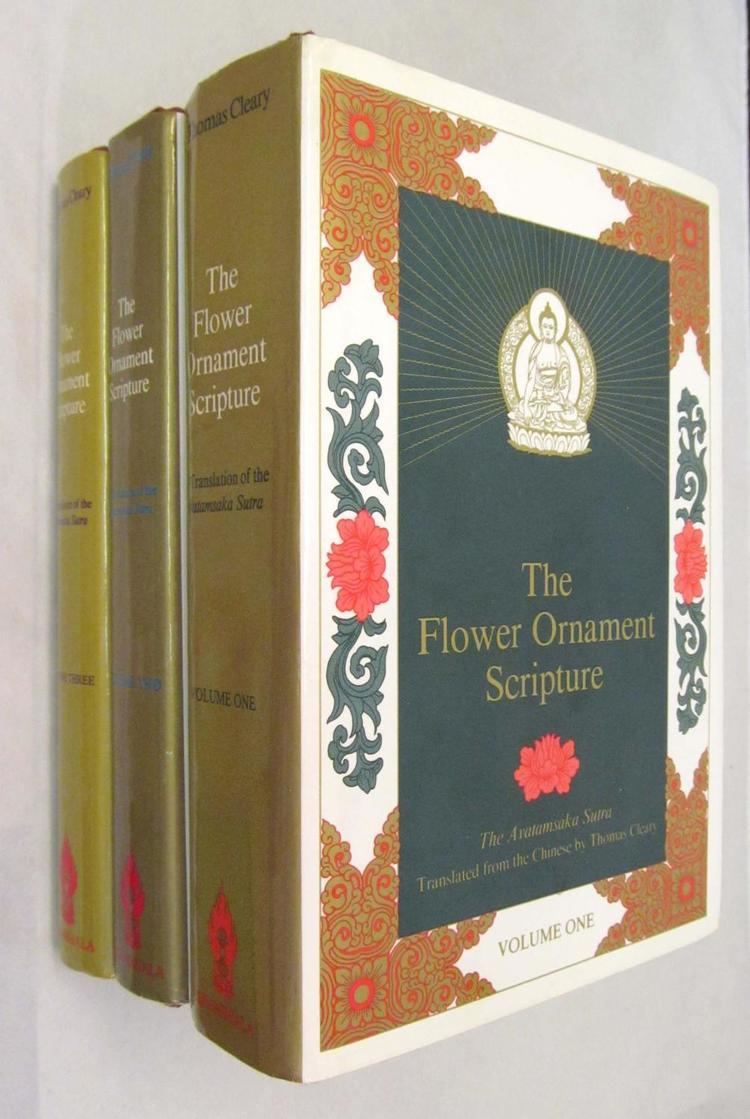 | ||
Similar Diamond Sutra, Longer Sukhāvatīvyūha Sūtra, Shorter Sukhāvatīvyūha Sūtra, Heart Sutra, Vimalakirti Sutra | ||
The vows of bodhisattva samantabhadra sutra 1080p from fascicle 40 of 40 of avatamsaka sutra
The Avataṃsaka Sūtra (Sanskrit; alternatively, the Mahāvaipulya Buddhāvataṃsaka Sūtra) is one of the most influential Mahayana sutras of East Asian Buddhism. The title is rendered in English as Flower Garland Sutra, Flower Adornment Sutra, or Flower Ornament Scripture.
Contents
- The vows of bodhisattva samantabhadra sutra 1080p from fascicle 40 of 40 of avatamsaka sutra
- Title
- History
- Format
- Ten Stages
- Gaavyha
- English translations
- References
The Avataṃsaka Sūtra describes a cosmos of infinite realms upon realms, mutually containing one another. The vision expressed in this work was the foundation for the creation of the Huayan school of Chinese Buddhism, which was characterized by a philosophy of interpenetration. The Huayan school is known as Hwaeom in Korea and Kegon in Japan.
Title
This work has been used in a variety of countries. Some major traditional titles include the following:
According to a Dunhuang manuscript, this text was also known as the Bodhisattvapiṭaka Buddhāvataṃsaka Sūtra.
History
The Avataṃsaka Sūtra was written in stages, beginning from at least 500 years after the death of the Buddha. One source claims that it is "a very long text composed of a number of originally independent scriptures of diverse provenance, all of which were combined, probably in Central Asia, in the late third or the fourth century CE." Two full Chinese translations of the Avataṃsaka Sūtra were made. Fragmentary translation probably began in the 2nd century CE, and the famous Ten Stages Sutra, often treated as an individual scripture, was first translated in the 3rd century. The first complete Chinese version was completed by Buddhabhadra around 420 in 60 scrolls with 34 chapters, and the second by Śikṣānanda around 699 in 80 scrolls with 40 chapters. There is also a translation of the Gaṇḍavyūha section by Prajñā around 798. The second translation includes more sutras than the first, and the Tibetan translation, which is still later, includes many differences with the 80 scrolls version. Scholars conclude that sutras were being added to the collection.
According to Paramārtha, a 6th-century monk from Ujjain in central India, the Avataṃsaka Sūtra is also called the "Bodhisattva Piṭaka." In his translation of the Mahāyānasaṃgrahabhāṣya, there is a reference to the Bodhisattva Piṭaka, which Paramārtha notes is the same as the Avataṃsaka Sūtra in 100,000 lines. Identification of the Avataṃsaka Sūtra as a "Bodhisattva Piṭaka" was also recorded in the colophon of a Chinese manuscript at the Mogao Caves: "Explication of the Ten Stages, entitled Creator of the Wisdom of an Omniscient Being by Degrees, a chapter of the Mahāyāna sūtra Bodhisattvapiṭaka Buddhāvataṃsaka, has ended."
Format
The sutra, among the longest in the Buddhist canon, contains 40 chapters on disparate topics, although there are overarching themes:
Two of the chapters serve as sutras in their own right, and have been cited in the writings of many Buddhists in East Asia.
Ten Stages
The sutra is also well known for its detailed description of the course of the bodhisattva's practice through ten stages where the Ten Stages Sutra, or Daśabhūmika Sūtra (十地經, Wylie: phags pa sa bcu pa'i mdo), is the name given to this chapter of the Avataṃsaka Sūtra. This sutra gives details on the ten stages (bhūmis) of development a bodhisattva must undergo to attain supreme enlightenment. The ten stages are also depicted in the Laṅkāvatāra Sūtra and the Śūraṅgama Sūtra. The sutra also touches on the subject of the development of the "aspiration for Enlightenment" (bodhicitta) to attain supreme buddhahood.
Gaṇḍavyūha
The last chapter of the Avatamsaka circulates as a separate and important text known as the Gaṇḍavyūha Sutra (lit. 'flower-array' or 'bouquet'; 入法界品 ‘Entering the Dharma Realm’). Considered the "climax" of the larger text, this section details the pilgrimage of the youth Sudhana to various lands at the behest of the bodhisattva Mañjuśrī.
Despite its being at the end of the Avataṃsaka, the Gaṇḍavyūha — and the Ten Stages — is generally believed to be the oldest component written.
English translations
The Avataṃsaka Sūtra was translated in its entirety from the Śikṣānanda edition by Thomas Cleary, and was divided originally into three volumes. The latest edition, from 1993, is contained in a large single volume spanning 1656 pages.
In addition to Thomas Cleary's translation, the City of Ten Thousand Buddhas is translating the Avataṃsaka Sūtra along with a lengthy commentary by Venerable Hsuan Hua. Currently over twenty volumes are available, and it is estimated that there may be 75-100 volumes in the complete edition.
